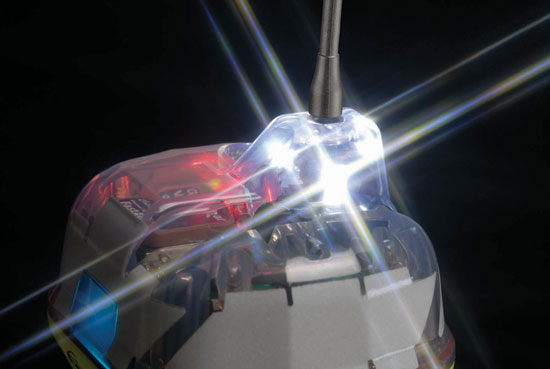EPIRB vs Moonlight: How Do You Want the Coast Guard to Search for You?
New technology, including NOAA-Registered EPIRB's, can shorten search times when trouble occurs.
October 4, 2010
This September 5 article from CNN had me shaking my head in disbelief at the—well, there’s only one word for it—stupidity that some boaters bring out to sea instead of proper equipment.

The ACR Global Fix iPro includes a strobe light.
According to the article, the U.S. Coast Guard had to search by no other means than moonlight (moonlight!) for seven boaters whose 38-footer sank off the coast of Charleston, South Carolina. The boaters, who included three children, were wearing life jackets and clinging to a cooler in the middle of the night. One boater’s wife called the Coast Guard after her husband failed to return home; the boat itself had no communications equipment, not even a basic VHF radio or a flare that could alert the Coast Guard to the sinking or location.
Contrast that situation with the one that the owners of the 48-foot Swan sailing yacht Victoria found themselves in this past June, when their yacht hit a submerged object and sank about 100 miles south of Puerto Rico—“really out there in the middle of nowhere,” as Coast Guard public affairs officer Ricardo Castrodad put it. Victoria’s couple had a life raft equipped with a water-activated, 406-megahertz EPIRB that that they had registered with the National Oceanic and Atmospheric Administration to let the authorities know where they expected to be should anything go wrong.
Though the Victoria couple’s distance from land was much farther than that of the South Carolina boaters and in fact stretched the limits of how far Coast Guard helicopters can reach before fuel runs out, they were saved much faster and easier thanks to the precise information that their safety equipment provided. Newer 406-mhz EPIRBs like theirs automatically send a satellite signal to the Coast Guard’s control center, including a GPS location for rescuers to use.
“If other mariners would practice what this couple did, it would help not just the Coast Guard, but all rescue organizations,” Castrodad told me. “You can drift the wrong way and never be found.”
If not for the luck of a generally cloud-free night and some bright moonbeams, that’s exactly what would have happened to those seven people off the coast of South Carolina. Personal locator beacons with 406-mhz EPIRBs built in start at less than $400 through West Marine.












